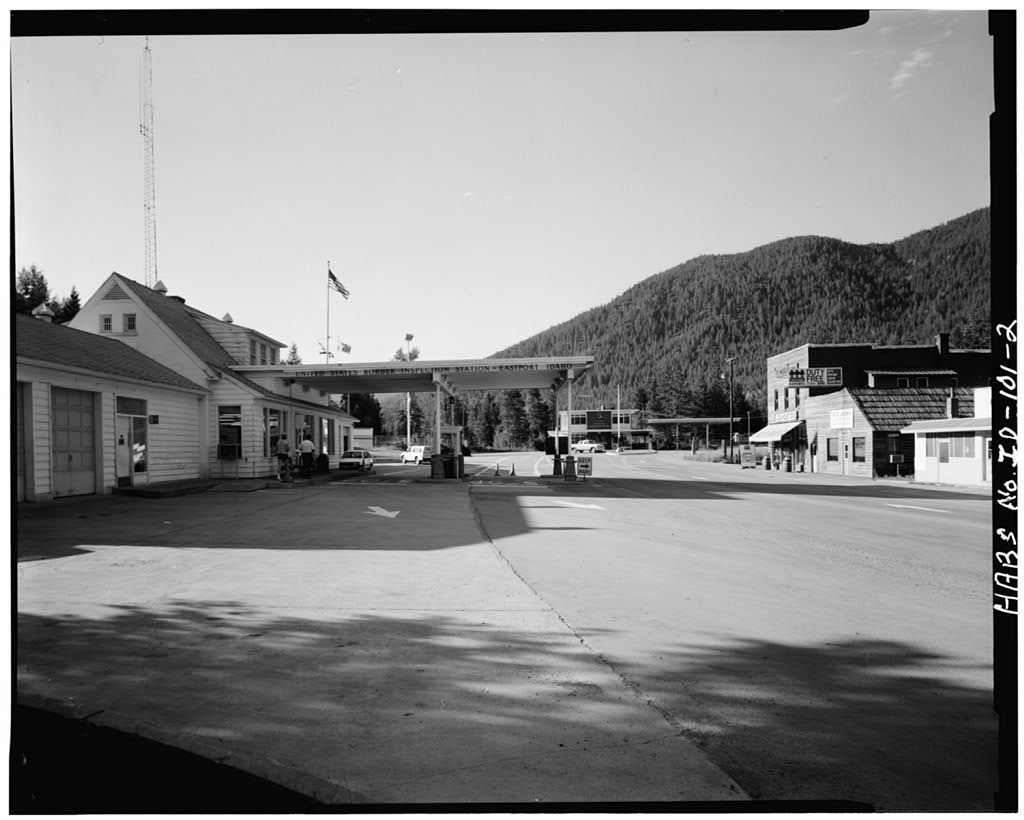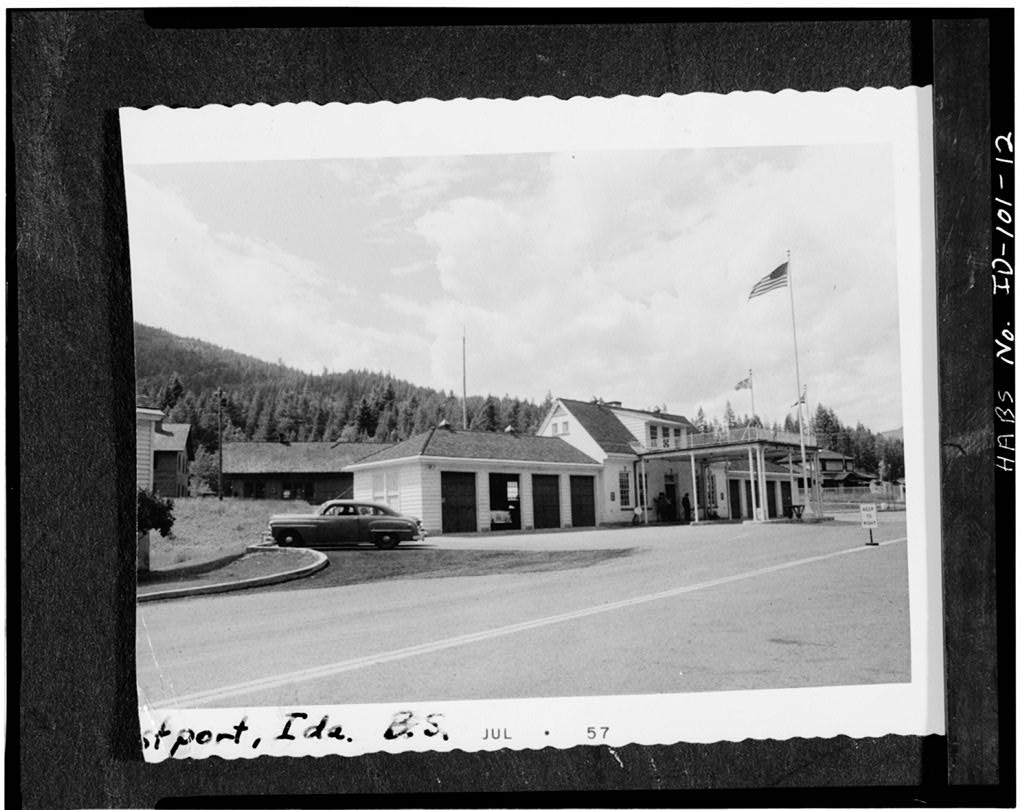The following article was written by the "Historic American Building Survey" about Eastport and the construction of the border station in 1936. It was submitted to the National Park Service in 1990. Quite often the author cites the Bonners Ferry Herald of 1936.
Surnames: John Sims, Albert Carter, W. Avery, Spencer Lewis, W.E. Hall, Andrew F. Mowat, W. Eric Pierce, Mr. and Mrs. G. Fallon, Mr. and Mrs. John W. Maudlin, L. Meikle.
Eastport is a small settlement on the Canadian Border in north Idaho. It lies
in a deep mountainous valley along the Moyie River and U.S. Highway 95 about
32 miles from Bonners Ferry, the closest town. Eastport is one of two border
crossings in Idaho, the other being Porthill several miles to the west.
The village was born in 1906 when the Spokane International Railroad (SI) was
constructed north into Canada. As the meeting place of the SI and Canadian
 Pacific Railroad, Eastport and its sister station, Kingsgate, across the border
Pacific Railroad, Eastport and its sister station, Kingsgate, across the border
became a railroad switching point. Engines, cabooses, and rail crews were
switched as trains moved freight and passengers north and south. U.S.
Customs and Immigration officials and their Canadian counterparts arrived to
inspect and assess duties on cargo and keep a watch on the human traffic
crossing the undefended border.
From the beginning it was clear that the two rail and inspection stations and
their attendant crews comprised one inseparable community. In this settlement
numbering from 100 to 200 citizens, a single one-room school served the
children of both countries, until its closure in 1940. The one community hall
was the scene of Sunday morning church services, silent movies on Saturday
nights, local theater productions, and Christmas programs. Bridge, cribbage,
skating and ski competitions were frequent, usually between American and
Canadian teams. The ski jump attracted much attention in winter and was
truly an international event: jumpers took to the air on one side of the
border and landed on the other. In summer tennis tournaments were held on
clay courts west of the SI depot, and the swimming hole straddling the
boundary line on the Moyie River was busy on hot days. Fireworks were set
off on both the first and fourth of July in honor of both nations* national
holidays.
Aside from railroading, local citizens found opportunities for making a living
available, albeit limited in the surrounding countryside. In winter, some
harvested ice from small nearby lakes to fill the icehouse, which supplied
railroad cars hauling fruits and vegetables in summer. Cedar pole cutting "has
meant quite a little business in this district," reported the Bonners Ferry
Herald in referring to the Eastport vicinity (3/5/36, p. 2). The same issue
alluded to the diversity of economic endeavors in reporting an Eastport man's
seasonal employment: "Norman has finished his winter's sojourn on the trap
line." Local businesses included Albert Carter's hotel and general store
(otherwise known as the Idaho Hotel, which still stands across Highway 95
from the U.S. Inspection Station), W. Avery's restaurant next door, John Sims'
cafe adjacent to the SI depot, and the Royal Hotel across the line in
Kingsgate. By the spring of 1936, Eastport residents were petitioning to have
electricity brought to the community as was being done for Porthill, the other
Idaho border crossing to the west.
In 1934 the federal government paid $1,150 for property in Eastport on which
to build a new inspection station and residences for inspectors and their
families. At that time numerous structures that have since been razed stood
on and adjacent to the property. John Sims* log and frame house was located
on land now occupied by the present station. A few feet behind the house
stood his "power house" amidst terraced gardens. To the southeast along an
unpaved drive stood two garages and Spencer Lewis' frame building. In the
vicinity of the present government house furthest to the south, W.E. Hall
owned the frame cabin labeled "Border Patrol" on a 1935 survey map of the
area. Five unidentified cabins stood along the Moyie River south of the
government property line west from near the graveled Federal Forest Road on
the present Highway 95 route.
Northwest of the present station and east of the railroad depot stood the
Boundary Cafe, owned by the SI Railroad. Immediately to the north on the
boundary line was a frame Immigration and Customs cabin. The SI depot stood
where the present depot is located. The U.S. Customs office occupied the
north end of the depot, while the U.S. Immigration Service occupied a building
directly south of the depot also owned by the railroad.
During the Great Depression of the 1930s, considerable amounts of federal
money were spent in Idaho on New Deal programs through the Works Progress
Administration, the Civilian Conservation Corps, and other programs. It was
during that period that funds became available for building a new inspection
station and nouses for Customs and Immigration officials and their families at
Eastport. (Congress actually appropriated $59,000 for the buildings in 1931,
but a contract was not issued until four years later). Unlike many other
Depression-era projects, construction of the facilities was done by a private
contractor and not by one of the many federal work forces active in the
region.
On 16 November 1935, the federal government signed a contract with Andrew
F. Mowat, a Seattle construction contractor, to build an inspection station and
two residences at Eastport. The contract amount was for $53,548.00, but
records indicate construction costs ran to $56,333. Mowat had bid $53,728.00,
but the contract reduced that amount by $180 in substituting shingle tiles for
the slate roof specified in the preliminary drawings.
Local Indians and trappers had correctly predicted the winter of 1935-1936 to
be unusually severe. Perhaps the weather had something to do with the delay
in starting construction on the buildings. The first load of materials arrived
by rail in early February, and the newspaper predicted "a start is expected at
any time." (Herald. 2/13/36, p. 2). W.E. Pierce, the field engineer for the
project, and his wife and young children arrived in late February and took up
residence in Carter's Hotel across the highway. (Herald. 2/27/36, p. 3).
In late March, "considerable numbers" of workmen arrived to begin work on
the buildings. The Bonners Ferry Herald (3/26/36, p. 2) carried a colorful
account of construction activities in their earliest stages:
Eric, the engineer, was dashing around in all the orthodox
paraphernalia of high laced boots, bright mackinaw and
transit, one pocket stuffed full of blueprints and the other
with the inevitable field book, setting up his gun and waving
excitedly to his rodman, "Up a little; down one, Atta boy!"
Important looking men with their hats settled on the backs of
their heads, huddled together over more prints, while
carpenters ran around with axes and bundles of stakes, driving
them here, there and everywhere. Albert Carter was fixing up
the front of his store, while John Sims was putting the
finishing touches on the restaurant's first coat of paint.
Bad weather held up construction in early April, but good progress was made
later that spring. By mid June, the brickwork on the station was nearly
complete, the two houses were roofed and their fireplaces installed. The
Herald reported: "The cluster of buildings have quite an imposing appearance
from the highway and when the plans for landscaping are completed will form
a very attractive settlement." (6/18/36, p. 2). By July the canopy was
finished, with its "light ornamental railing . . . which adds greatly to its
appearance," so the paper reported. (Herald, 7/2/36, p. 5). By mid August,
the structures were "rapidly approaching completion. All the buildings have
been plastered and the painters are busy with the decorating." The driveways
were graded and graveled awaiting asphalt, and local children were discovering
the advantages of roller skating and bike riding on the cement sidewalks and
approaches. (Herald. 8/13/36. p. 2).
In September 1936 the exteriors of all the new federal buildings at Eastport
were painted white and work on the interiors was nearing an end. (Herald.
9/17/36, p. 2). During the first week in November, W.E. Pierce, field engineer
in charge of the project, arrived to conduct a final inspection of the buildings
before they were officially turned over to the Customs and Immigration
services. A temporary Customs station erected along the highway had closed
by then, perhaps indicating that the new station was already occupied.
(HeraJd, 11/5/36, p. 2).
By 12 November 1936, Mr. and Mrs. G. Fallon had moved into the new Customs
Service house (closest to the station), and Mr. and Mrs. John W. Maudlin had
moved into the Immigration and Naturalization Service house to the south.
(Herald. 11/12/36, p. 2). G. Fallon was at that time the Chief Customs
inspector, while Maudlin was an Immigration Officer at the post. L. Meikle,
who the newspaper described as being a new permanent resident, became the
"caretaker" of the station building. (Herald. 11/19/36, p. 2).
Over the years the inspection station has undergone considerable modification
and is still in use (as of January 1989). The houses, on the other hand,
have been altered very little. They were last occupied seasonally 8 or 9 years
ago and year around perhaps 13 or 14 years ago.
2016 NOTE: The 1936 inspection station was replaced in 2012.
:: "Boundary Team - August 2016" ::
